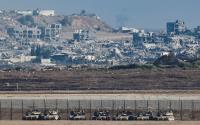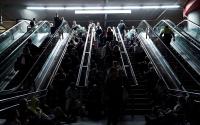18 April 2006Robert Gehrke
Pentagon apparently looks for an optimal size of a "bunker buster."
|
The detonation, called Divine Strake, is intended to "develop a planning tool to improve the warfighter's confidence in selecting the smallest proper nuclear yield necessary to destroy underground facilities while minimizing collateral damage," according to Defense Department budget documents.
Irene Smith, a spokeswoman for the Pentagon's Defense Threat Reduction Agency, said the document doesn't imply that Divine Strake
"is a nuclear simulation." She said it will be used to assess computer programs that predict ground shaking in a major blast.
While it will not be a nuclear explosion - no nuclear or radioactive material will be used - the Divine Strake blast will be fifty times larger than the military's largest conventional weapon, the Massive Ordinance Air Blast Bomb, or MOAB, nicknamed the Mother of All Bombs. It will still be many times less powerful than the smallest weapon in the U.S. nuclear stockpile.
"It seems like what they're doing is trying to use the explosive power to shake the interior into pieces, rather than sending an earth penetrator down to dig it up," said Hans Kristensen, a nuclear weapons expert with the Federation of American Scientists. "What it apparently does is envision the use of the nuke on the surface, and that is a very dirty business, because it sucks up the material and throws it into the atmosphere."
Divine Strake has some advocates concerned that the Bush administration is using the test to pursue development of low-yield, tactical nuclear weapons.
"We certainly have reason for concern," said Vanessa Pierce, a project director with Health Environment Alliance of Utah. "I think this test shows that the weapons designers are so obsessed with creating new nuclear weapons like mini-nukes that they'll do whatever it takes to get their fix."
"There really is a deep commitment on the part of this administration to creating new types of nuclear weapons," Pierce said.
Senate Minority Leader Harry Reid has expressed concern about the mushroom cloud the test will produce, and asked Defense Secretary Donald Rumsfeld for a classified briefing on Divine Strake. Reid is scheduled to meet with James Tegnelia of the Defense Threat Reduction Agency this afternoon.
The June 2 test will entail piling 700 tons of ammonium nitrate and fuel oil atop a buried limestone tunnel on the Nevada Test Site, then detonating it to measure the damage that would be done to the chambers.
The mixture that will be used is similar to the bomb that Timothy McVeigh used to blow up the Alfred P. Murrah federal building in Oklahoma City in 1995, only the Nevada bomb will use 280 times as much material.
Equipment inside and near the tunnel will monitor damage and ground shaking from the blast. Dust from the mushroom cloud, which could reach heights of 10,000 feet, will also be tracked.
J. Preston Truman, director of the group Downwinders, which represents individuals sickened by radioactive fallout from Cold War-era nuclear tests, scoffs at the Pentagon's suggestion that it is not a nuclear simulation, arguing no military plane could drop a 700-ton conventional bomb.
"It's for one thing and one thing only," he said. "It just says they're still pursuing these stupid, insane weapons."
The nuclear tie-in to Divine Strake test was rooted out by Kristensen and Andrew Lichterman, a nuclear weapons opponent and blogger.
"It's not a step toward nuclear testing. It is nuclear testing. It's just nuclear testing the way it's done today," since actual nuclear tests are banned by treaties, Kristensen said.
Similar above-ground detonations, some many times larger, have been conducted at White Sands Missile Range in New Mexico, according to planning documents for Divine Strake, but none since 1991.
The Defense Department's 2001 Nuclear Posture Review lays out a new, broader role envisioned for nuclear weapons than the part played during the Cold War.
"Non-nuclear strike capabilities may be particularly useful to limit collateral damage and conflict escalation. Nuclear weapons could be employed against targets able to withstand non-nuclear attack, (for example, deep underground bunkers or bio-weapon facilities)," the report says.
In addition, the Bush administration has pushed for funding for a nuclear bunker buster, and money to enable the Nevada Test Site to be able to test a weapon within two years if an order is given.
It has also supported the repeal of a 1994 congressional ban on the development of low-yield mini-nuclear weapons.
The ban was repealed by Congress in 2003, allowing research of low-yield nuclear weapons, but requiring specific approval by Congress before engineering or other work on mini-nukes can begin.
Scientists Say Planned Blast a Part of Nuclear Testing By Launce Rake The Las Vegas Sun
Wednesday 05 April 2006
The Defense Department's plan to detonate 700 tons of explosives at the Nevada Test Site is intended to simulate a nuclear blast as part of Pentagon research into development of low-yield nuclear weapons, a science advisory group charged Tuesday.
The Pentagon refused to confirm or deny the claim, made by the Federation of American Scientists, a Washington, D.C.-based liberal policy group opposed to development of nuclear weapons.
But if the charge is verified, debate over the blast seems certain to shift beyond environmental effects on Nevada to international concerns over nuclear weapons proliferation.
The federation said it based its statement on a review of Pentagon budget requests since 2002 showing that the blast, scheduled for June 2, would serve as a "low-yield nuclear weapon simulation." Hans Kristensen, an analyst for the federation, said the Pentagon's Defense Threat Reduction Agency has carefully ducked the issue of whether the test was nuclear-related.
Policy analysts in and out of the Bush administration have suggested that the United States develop low-yield nuclear weapons. In 2001, the National Institute for Public Policy, a conservative nonprofit think tank, said new nuclear warheads should be developed for "bunker busting."
The Bush administration followed in 2002 with its Nuclear Posture Review, which made a similar argument. One of the veterans of the National Institute for Public Policy report, Linton Brooks, became the head of the National Nuclear Security Administration, which directs nuclear weapons research.
According to the Washington Post, a year ago Brooks told Congress that the United States lacked a nuclear warhead capable of destroying "hardened, deeply buried targets."
Despite the enthusiasm for the weapons research, Congress since 2001 has denied funding for such nuclear programs. Last year Congress cut $4 million from the administration's request to study a nuclear bunker buster, instead supporting study of a conventional weapon that could be used against buried targets.
Rep. David Hobson, R-Ohio, chairman of a key House subcommittee on the weapons issue, said in December that Congress would not back a ground-penetrating nuclear warhead. The Nuclear Threat Initiative, a nonprofit group working to reduce the likelihood of the use of nuclear weapons, said in November that the Bush administration would go ahead with a test of a mock earth-penetrating nuclear warhead, but with a different name and using Defense rather than Energy Department funding.
Kristensen said the test, while non-nuclear, could be used to further development of a nuclear bunker-busting warhead.
The test "is about fine-tuning tools for fighting nuclear wars, Kristensen said. The nuclear war fighters are trying to calibrate a low-yield nuclear weapon against a relatively shallow target in limestone."
Kristensen said the goal of the test program was to find the weakest nuclear weapon that would still achieve the goal of knocking out hardened, underground structures. Lower-yield weapons would spread less radiation and fallout that would affect civilians and troops.
Kristensen's comments came less than a week after James Tegnelia, director of the Threat Reduction Agency, told reporters that the test would send "a mushroom cloud over Las Vegas." Although the agency quickly disavowed the comment and stressed that the test would be non-nuclear, the comment alarmed political leaders and residents who remember decades of atomic bomb tests at the Nevada Test Site, 65 miles northwest of Las Vegas.
Agency spokesmen said the explosion, although large, would not be seen, heard or felt in Las Vegas and would not produce any radioactive dust to blow downwind.
Asked Tuesday about the federation's comments, agency spokesman David Rigby said, "I don't confirm them. I don't deny them. I don't discuss the quality of their information.
"This is a test to have better predictive tools to defeating hardened and underground targets," Rigby said. "It is not a precursor to a nuclear test. It is not a nuclear test."
The June blast "has been redefined over the past several years," and the goal now is to provide data on how such massive explosions and their ground shocks affect structures in different geologic situations, he said.
Senate Minority Leader Harry Reid of Nevada is scheduled to meet with Tegnelia on Thursday. Sharyn Stein, a Reid spokeswoman, said the goal of the test would be discussed.
"Nevadans have heard a lot of frightening rumors about this planned test," Reid said in a prepared statement. "I look forward to talking with Director Tegnelia and getting accurate information. I'm pleased the director is able to meet with me so quickly, and I hope we'll be able to settle any concerns about the safety of Divine Strake," referring to the test.
State Sen. Dina Titus, a Democratic candidate for governor and a UNLV professor who has written extensively on Nevada's history with nuclear weapons testing, said people were concerned about a return of the atomic tests.
Past statements from the Bush administration on the need to resume such testing or develop new tactical nuclear weapons don't reassure people, she said.
"All the saber-rattling leads me to fear that they might try to resume testing," she said. "We won the arms race, so why are we starting it again?
"This is a more visceral issue even than Yucca Mountain because of the history of weapons testing. We have to have a strong defense, but I don't know why we would want to start the arms race again."







